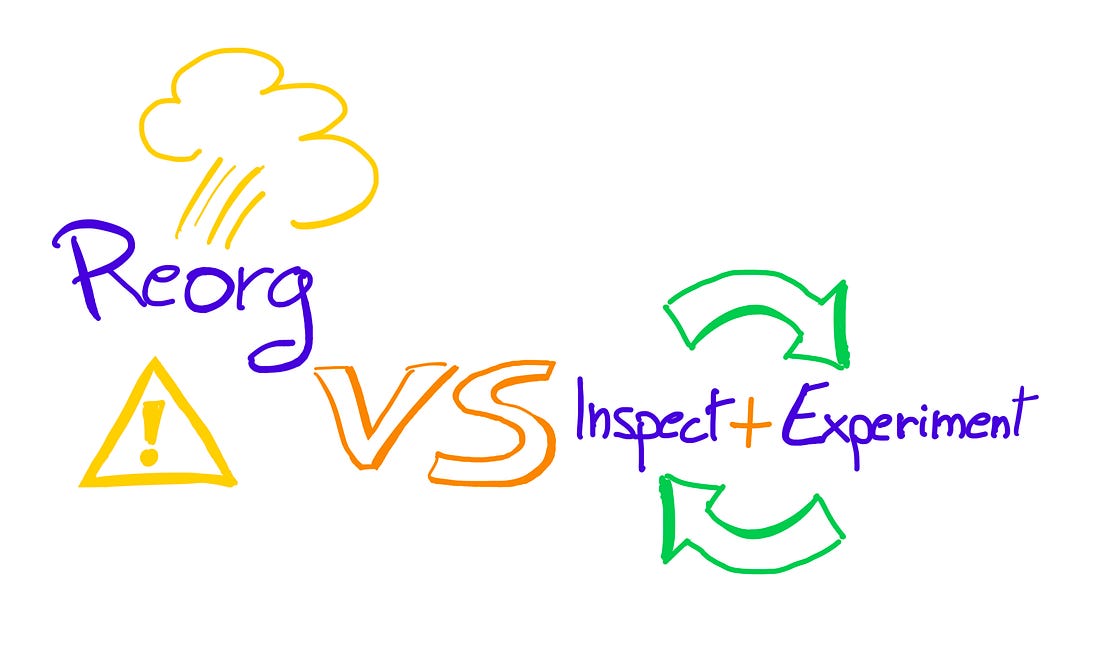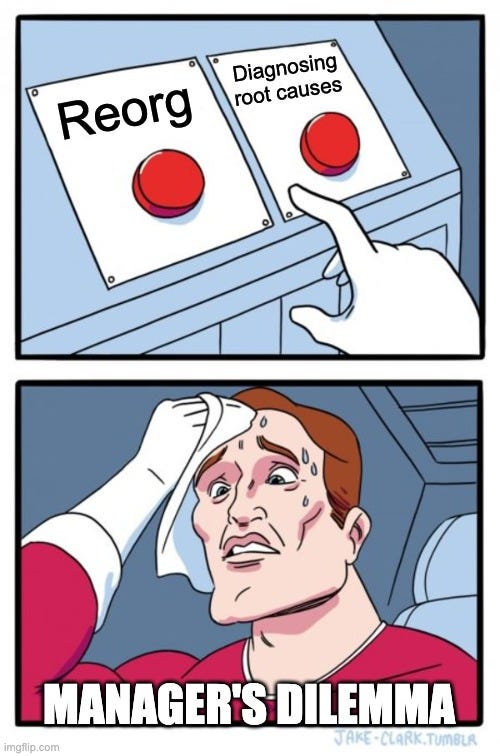Resisting the Reorg Itch
- Sergio Visinoni from Sudo Make Me a CTO <makemeacto@substack.com>
- Hidden Recipient <hidden@emailshot.io>
Hi, 👋 Sergio here! Welcome to another free post from the Sudo Make Me a CTO newsletter. If you prefer to read this post online, just click the article title. As this is a free newsletter, I do immensely appreciate likes, shares and comments. That's what helps other readers discover it! Resisting the Reorg ItchDon't fall for the temptation of bold hard to revert changes. Take an experimental approach inspired by the principles of agility instead.Today's issue relates again to an inspiring conversation in a recent Sudo Make Me a CTO community call. One of the members shared that they were considering a significant reorganization of the engineering team, which led to a rich discussion with community members on the topic. Reorganizations are common in the tech industry. They're often brandished as the ultimate solution to productivity or efficiency problems in large and small organizations. I'm confident that about half of the readers are just coming out of a significant organizational restructuring or are actively planning one. There are situations when a reorganization is the most sensible solution. Still, I argue that this approach is used too lightly and often in situations where other methods are more effective. Today, we will discuss why we have this reorg reflex and why it's often a bad idea. We'll dive into the real problems, explore better solutions, and maybe save you — and your team — one reorg too many. We'll start by forgetting about your reorganization idea and taking you back a few steps. Back to the basics of good leadership habits. Do You Intimately Understand the Problem?Before you start playing with boxes and lines on a Miro board, ask yourself: do you really know what's broken? Like, deeply know? It's tempting to jump to conclusions, but real problems hide in the details. This part is hard. It takes time. It can be uncomfortable. But it's the most important work you'll do. We've all felt the lure of a "fresh start" that a reorg promises. However, that clean slate is sometimes more of a short-term fix for the leader's frustrations than a solution to the company's systemic problem. Before you rush into such a decision, I recommend you roll up your sleeves and accept to go through the pains of understanding what might be going on in your team. You'll likely hate yourself as you go through the process, but I guarantee you will come out much better equipped at the tail end of the investigative tunnel.
Don't be fooled by the perceived simplicity of a reorg. It's simple for you, the decision maker, as it allows you to skip the pain of a lot of work trying to understand the situation while providing a comforting illusion of decisiveness and action. Acting on assumptions is a dangerous game, with massive downstream costs in terms of lost productivity, team morale, and market opportunities. Reorg as Your Last Option, Not Your First OneReorgs are like pulling the emergency brake on a speeding train. Yes, it'll stop, but you'll also derail a few cars and seriously injure a few passengers. The price tag of a reorg is often underestimated. What we frequently dismiss as a reasonable "one-time expense" to make up new org chart slides, a couple of all-hands, and then a few more handover meetings, tends to have massive hidden costs.
There are many other things you can likely try out before you hastily push the thermonuclear reorg button. Remembering the Principles of Agile Software DevelopmentEven though The Manifesto for Agile Software Development¹ was written more than 20 years ago, many companies and teams still fail to embody those key principles in how they operate. They might go through the performative dance of backlogs, iterations, and standups but still reason in ways opposite the key principles. Similarly, big reorgs are performative. They can give the impression of boldness and moving fast. Of doing the right thing, even when it isn't. One of the best definitions of Agility I have ever heard is beautiful in its simplicity and goes like this²:
The definition applies to any domain: code, organizational design, or even life itself. When applied to organizational challenges, it can become a powerful means to deal with them. Instead of a big-bang reorg, what if we tried small, focused changes? We'd take fewer risks, learn faster, and contribute to building a culture of learning and experimentation across the entire organization. This could be a good way to practice the famous 1% improvement daily concept³. So, when you're facing an organizational-related issue, which for 98% of you out there is likely an iteration on we aren't shipping fast enough, consider the following approach instead of complete reorg:
It's less dramatic than a reorganization but much more effective. Instead of making large, often irreversible changes with a reorg, incremental experimentation allows for continuous learning and adjustments based on real-world feedback. This approach leads to more sustainable improvements in productivity and coordination. It provides plenty of opportunities to reassess and pivot and has lower negative repercussions on the team's morale. You might have the impression that you are moving too slowly, but slowly and steadily moving in the right direction is better than moving very quickly in the wrong direction, especially when compounded with the high cost of reversing significant changes. Think of it as another instance of the Festina lente⁴ principle that inspired many stoic philosophers and practitioners. Stop the Reorg Reflex and Join the ConversationThe next time you feel the reorg itch, I recommend you resist it. Take a deep breath, grab your data, and start diagnosing. Reorgs have their place, but they shouldn't be your default weapon. Let's embrace a more incremental, experimental approach to organizational change. Want to dive deeper into these topics? You are just one click away from joining the Sudo Make Me a CTO Community and start building better teams and more successful organizations with the support of all its members. It can be another 1% improvement change that will have massive compound effects on your career. Don't just take my word for it. Here is what Mauro, one of our members, says about being part of the community:
If you like what you read in this newsletter, you'll love what we'll discuss with you in the community. See you soon! 1 I'd be surprised if anyone needed a link to the Manifesto, but if you don't know where to find it, here it is. 2 I first encountered it in this video from Dave Thomas in 2015. It's a recommended watch for anyone, and even 10 years later, it's still very much on point. 3 Check out this article from James Clear on the topic. 4 Check out this Wikipedia page for a quick intro to the concept. Sudo Make Me a CTO is a free newsletter edited by Sergio Visinoni. If you found this post insightful, please share it with your network using the link below. If you or your company need help with one of the topics I talk about in my newsletter, feel free to visit my website where you can schedule a free 30 minutes discovery call. I'd be delighted to investigate opportunities for collaboration! |
Similar newsletters
There are other similar shared emails that you might be interested in:

